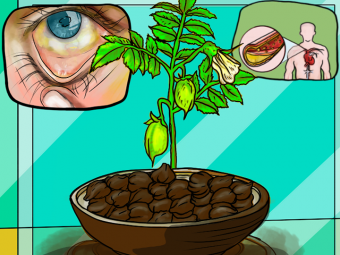The lotus root is a vegetable root with therapeutic benefits. It has been used in Asian traditional medicine for centuries. Lotus root benefits your health in a number of ways, thanks to its rich nutrition profile. It is a great source of carbohydrates, fiber, and antioxidants that help treat many ailments.
This nutritional food source is used to add seasoning to foods and has several culinary applications too. This article explores the nutritional breakdown of lotus root, its health benefits, how to include it in your diet, and its possible side effects. Keep reading.
In This Article
What Is Lotus Root?
Lotus (Nelumbo nucifera Gaertn.) belongs to the aquatic flowering plants family Nelumbonaceae. It is widely cultivated in China, Korea, Japan, and India as an ornamental plant for food and medicinal purposes (1). Lotus roots are its submerged stems. They are cylindrical and segmented (like connected sausages). The tubular roots have air channels running along their lengths, and when you cut them, you will see holes (2).
Elliot Reimers, CISSN, CNC, says, “Lotus root is a plant mostly found in lakes and rivers. There are a number of uses to the lotus root in regards to medicine, and almost the entire plant has different medicinal qualities.”
The roots of its use in traditional medicine could be traced to its nutritional value.
He adds, “Lotus root is full of many important minerals, nutrients, and vitamins, and it is also an amazing source of fiber.” Scroll down to check the wide range of nutrients it contains.
Lotus Root Nutritional Information
A hundred grams of cooked lotus root contains (3):
|
Calories |
86 kcal |
|
Proteins |
1.54 g |
|
Carbohydrates |
15.5 g |
|
Total lipids (Fat) |
2.6 g |
|
Calcium |
26 mg |
|
Potassium |
352 mg |
|
Magnesium |
21 mg |
|
Sodium |
166 mg |
|
Phosphorus |
76 mg |
|
Iron |
0.87 mg |
Reimers adds, “The fiber that comes from the lotus root has been said to help our bodies with the regulation of blood sugar and can also help improve our digestion.” Here are some other reasons to eat lotus root.
Health Benefits Of Lotus Root
1. May Protect The Liver
A mice study found that oral lotus root powder could prevent non-alcoholic fatty liver disease. Researchers found that lotus roots could suppress inflammatory gene expression associated with the condition, increase serum adiponectin levels, and protect the liver (4).
2. May Protect Against Stomach Ulcers
A study on rats showed that fermented lotus root could protect the stomach against stomach ulcers. It has antioxidant and anti-inflammatory properties that add to its gastroprotective effects and speed up the recovery of the mucous layer of the stomach (gastric mucosa) (5).
3. May Reduce Inflammation
Fermented lotus roots contain linoleic acid. This fatty acid can reduce inflammatory responses within the body and help prevent acute inflammatory conditions like acute hepatitis and autoimmune diseases (6).
4. May Help Manage Diabetes
An animal study found that lotus root extract could significantly reduce blood sugar levels in diabetic and normal rats. Researchers also observed improved glucose tolerance and insulin action (7). Consuming lotus root extract may have a similar effect in humans. However, more human studies are required to substantiate the effect.
5. May Treat Allergy
A mice study found that lotus root powder could reduce nasal allergy symptoms in mice. It contains vitamin C and other polyphenolic compounds that can reduce serum histamine (a compound released by cells that triggers allergic reactions) levels and other inflammatory parameters (8).
6. May Promote Gut Health
Lotus roots are a good source of dietary fiber. A fiber-rich diet promotes regular bowel movements and increases fecal weight and frequency (9).
7. May Control Weight Gain
Lotus root extract can reduce fat tissue weight (adipocytes) and have anti-obesity effects in human cells. It prevents lipid accumulation in cells and may lower blood cholesterol levels (10). This may also help prevent obesity-related conditions.
8. May Promote Heart Health
Potassium in the roots helps to reduce the bad LDL cholesterol by acting as a great vasodilator. It also prevents arteries from clogging up and reduces the risk of heart attacks. Pyridoxine in lotus roots helps manage homocysteine levels in the blood and protects the heart. High homocysteine levels in the blood damage the lining of the arteries.
9. May Help Reduce Stress
Vitamin B complex, especially pyridoxine in the lotus root, interacts with neural receptors of our brain and may help reduce stress, irritability, and headaches.
Reimers says, “Some of the other reasons lotus root is good for you include that it’s not a common food allergen, it has a low water footprint, and it is naturally gluten-free.” Also, it contains vitamin B and C, which are essential for healthy skin and hair. These benefits make it worthwhile to include lotus root in your diet. Here’s how you can do it.
How To Add Lotus Root To Your Diet: Popular Recipes
Lotus root is mildly sweet and has a crunchy, starchy texture. As it cooks, it softens without losing its crunch and flavor. The vegetable is versatile – it is crisp when stir-fried and tender and creamy when baked.
You cannot consume raw lotus roots as they increase the chance of bacterial infections; you need to either boil or steam them. Peel off its skin and rinse it thoroughly before boiling for 10 minutes. However, if you want to soften its texture, boil the roots for not more than 20 minutes. Here are a few recipes to try.
1. Lotus Root Stir-Fry
Make your lunchtime a little more exciting with this savory side dish.
What You Need
- 300 g lotus root
- 1 cup of mushrooms (chopped)
- ½ cup of red bell pepper (chopped)
- ¼ cup of chicken stock
- 2 teaspoons of oyster sauce
- ¼ teaspoon of sugar
- 1/8 teaspoon of white pepper
- 2 tablespoons of oil
- 6 slices of ginger
- 2 garlic cloves (minced)
- 2 scallions (chopped)
- 1 tablespoon of dry sherry
- 2 teaspoons of cornstarch
- Salt, as needed
How To Prepare
- Blanch lotus roots, mushrooms, and bell peppers for 45 seconds and set aside.
- Mix the chicken stock, oyster sauce, salt, sugar, and white pepper in a small bowl to make the sauce mixture.
- Sauté ginger, garlic, and scallions for a minute over medium heat.
- Add the blanched vegetables and stir-fry for 1 minute.
- Add dry sherry around the edge of the wok, followed by the sauce mixture.
- Add the cornstarch-water mix and cook for 30 seconds until the sauce is simmering.
- Stir-fry for another 20-30 seconds until the sauce coats the vegetables, and serve.
Subscribe
2. Baked Lotus Root Chips
Replace the potato chips with this tasty snack! Create your flavor by mixing different spices.
What You Need
- 200 g lotus roots
- 1 teaspoon of black pepper (freshly ground)
- ½ tablespoon of salt
- 2 tablespoons of olive oil
How To Prepare
- Preheat the oven to 325°F.
- Mix all the ingredients in a large bowl.
- Drizzle oil and arrange the sliced roots on a baking sheet.
- Bake for 20 minutes or until golden brown.
- Drain on a paper towel. Serve with a dip or add your blend of spices.
3. Pork And Lotus Root Soup
This hearty, flavorful soup will satisfy your soul and hunger.
What You Need
- 500 g lotus root
- 500 g pork ribs
- 100 g peanuts
- 1 carrot (peeled and chopped)
- 1 dried cuttlefish, rinsed (optional)
- 8 dates (dried, deseeded)
- Salt, as needed
How To Prepare
- Soak peanuts in boiling water for 30 minutes.
- Blanch pork ribs for 5 minutes and set aside.
- Slice the lotus roots into bite-sized pieces.
- Add all the ingredients to a soup pot and add water to cover them.
- Boil the soup. Cook it for 2-3 hours on low heat or until the meat is tender.
- Add salt and serve hot.
It is always best to consume fresh lotus roots. However, you can also store them for later use. Here are a few tips.
Tips To Store Lotus Root
You can refrigerate lotus roots for up to a week. Ensure to store peeled and sliced roots in an airtight container. Sliced lotus roots are prone to browning. You can soak them in vinegar to prevent browning. Discard the roots if they develop black spots or an unpleasant smell.
Lotus roots are delicious and healthy. However, you have to be careful while consuming them.
Side Effects And Allergies
Though it is rare, people can be allergic to lotus roots. There has been a case where a 6-year-old girl experienced allergic reactions after consuming fried lotus roots (11).
Reimers adds, “Some of the possible side effects of lotus root include bad breath, fever, diarrhea, and problems with the liver. While it is plant-based and has many health benefits, individuals should speak with their doctor before incorporating it into their diet too quickly.”
Lotus roots can be a great snack to munch on. They have a mildly sweet taste and are crunchy when fried or baked. This popular Asian ingredient is loaded with potent antioxidants, healthy carbs, vitamins, and minerals that support good health. Lotus root health benefits range from protecting the liver to promoting gut function. It may help reduce the harmful free radicals present in your body and reduce inflammation. Lotus root may help manage diabetes and weight loss as well. However, when consumed in excess, it can cause problems. You should limit its use and consult a doctor if any adverse reactions occur.
Frequently Asked Questions
Is lotus root high in carbs?
No. Lotus roots have a moderate level of carbs.
Is lotus root a nightshade plant?
No. The plants of the Solanum and Capsicum families belong to the nightshade family.
Key Takeaways
- Lotus is widely cultivated as an ornamental plant for food and medicinal reasons in China, Korea, Japan, and India.
- Its root has a rich nutritional profile that may protect the liver, reduce the risk of stomach ulcers, and treat allergies.
- The vegetable is used to enhance dishes and has various culinary uses.
- However, make sure you are not allergic to lotus roots before eating them.
References:
Articles on StyleCraze are backed by verified information from peer-reviewed and academic research papers, reputed organizations, research institutions, and medical associations to ensure accuracy and relevance. Read our editorial policy to learn more.
- Phenolic Profiles and Antioxidant Activity of Lotus Root Varieties
https://www.ncbi.nlm.nih.gov/pmc/articles/PMC6273286/ - The Latest Studies on Lotus (Nelumbo nucifera)-an Emerging Horticultural Model Plant
https://www.ncbi.nlm.nih.gov/pmc/articles/PMC6696627/ - Lotus root cooked FoodData Central
https://fdc.nal.usda.gov/fdc-app.html#/food-details/1103520/nutrients - Effects of Lotus Root (the Edible Rhizome of Nelumbo nucifera) on the Deveolopment of Non-Alcoholic Fatty Liver Disease in Obese Diabetic db/db Mice
https://academic.oup.com/bbb/article/76/3/462/5954677?login=true - Gastroprotective Effects of Fermented Lotus Root against Ethanol/HCl-Induced Gastric Mucosal Acute Toxicity in Rats
https://www.mdpi.com/2072-6643/12/3/808/htm - Anti-Inflammatory Effects of Fermented Lotus Root and Linoleic Acid in Lipopolysaccharide-Induced RAW 264.7 Cells
https://www.mdpi.com/2075-1729/10/11/293/htm - Effect of Nelumbo nucifera rhizome extract on blood sugar level in rats
https://www.sciencedirect.com/science/article/abs/pii/S0378874197001074 - Anti-allergic activity of lotus root (Nelumbo nucifera) powder in TDI-sensitized nasal allergy model mice
https://www.tandfonline.com/doi/full/10.1080/09540105.2019.1651255 - Dietary fiber and digestive health in children
https://academic.oup.com/nutritionreviews/article/75/4/241/3747768?login=true - Ethanol extract of lotus (Nelumbo nucifera) root exhibits an anti-adipogenic effect in human pre-adipocytes and anti-obesity and antioxidant effects in rats fed a high-fat diet
https://www.sciencedirect.com/science/article/abs/pii/S0271531714000165 - Identification of a novel food allergen in lotus root
https://www.researchgate.net/publication/317722192_Identification_of_a_novel_food_allergen_in_lotus_root
Related
The following two tabs change content below.
- Author
- Reviewer

Payal Karnik
Payal Karnik is a biotechnology graduate from the University of Mumbai with a keen interest in writing and a natural… more
Silky Mahajan
(MSc, CSN, CDE )Silky has been practicing nutrition for more than 14 years and is an active member of the Indian Dietetics Association… more



 29 Amazing Benefits Of Figs For Skin, Hair And Health
29 Amazing Benefits Of Figs For Skin, Hair And Health 19 Amazing Benefits Of Black Chickpeas (Kala Chana) For Skin, Hair And Health
19 Amazing Benefits Of Black Chickpeas (Kala Chana) For Skin, Hair And Health 28 Best Shea Butter Benefits For Skin, Hair And Health
28 Best Shea Butter Benefits For Skin, Hair And Health 15 Best Benefits Of Beta Carotene For Skin, Hair And Health
15 Best Benefits Of Beta Carotene For Skin, Hair And Health 29 Amazing Benefits Of Sesame Seeds For Skin And Health
29 Amazing Benefits Of Sesame Seeds For Skin And Health 4 Reasons Goat Cheese Is Better Than Cow Cheese
4 Reasons Goat Cheese Is Better Than Cow Cheese 38 Benefits Of Lime For Skin, Hair, And Health + Nutrition
38 Benefits Of Lime For Skin, Hair, And Health + Nutrition Rice Water For Skin – How To Use It For Maximum Benefits
Rice Water For Skin – How To Use It For Maximum Benefits 9 Benefits Of Cranberry Tea For Health And Recipes To Try
9 Benefits Of Cranberry Tea For Health And Recipes To Try